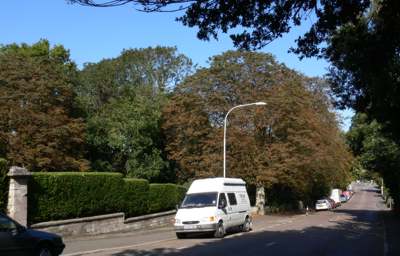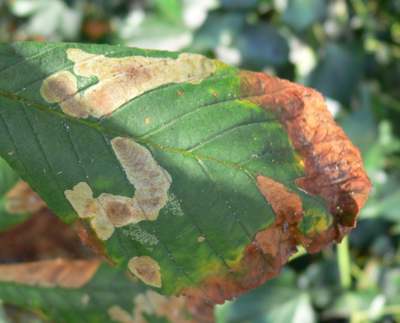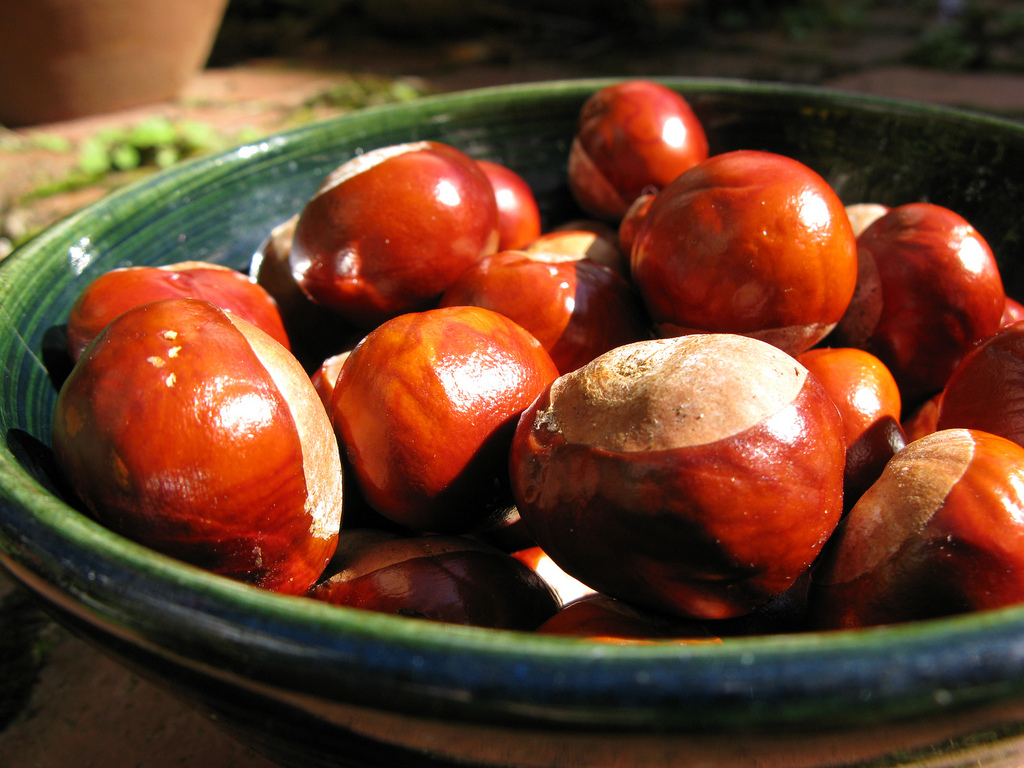Gather ye conkers while ye may
- Complaining about the Mainland - 17th August, 2024
- New island designation – is it just greenwash? - 26th April, 2024
- Police and Crime Commissioners – a solution or a problem? - 21st April, 2024
Step out and have a look at your local conker trees… if you live in England or Wales you may be surprised at what you see. Some of them look like they are shedding their leaves prematurely.

Closer examination suggests otherwise.

This season’s leaves are normal over some of their area, but something is attacking them, causing them to go brown and shrivelled.

This twig is actually regrowing new leaves where the previous ones fell off. The culprit is the Horse Chestnut Leaf Miner moth, Cameraria ohridella. This is the time of year when the damage caused by the leaf miner is becoming apparent. The caterpillars of the moth get in between the front and back of the leaves and nibble away at the soft flesh inside, hollowing it out (that’s the big white spots on the leaf in the photo). The moth can have up to six generations in a growing season, so the caterpillars just keep coming back while the leaves are still on the tree. This can affect the whole leaf too, and towards the end of the season it may die. When the leaf dies and falls off the caterpillar pupates inside the leaf, emerging in the spring as an adult to mate and lay eggs on the new leaves. The Horse Chestnut Leaf Miner was first observed in Macedonia in northern Greece in the late 1970’s, and was described as a new species in 1986. It spread west and was first found in the UK in Wimbledon in 2002. It now occurs commonly in horse chestnuts throughout central southern and eastern England, and is spreading steadily at 40-60km per year. Despite the alarming visual effect of the moth, it apparently has no long-term detrimental effect on the trees. However, as most horse chestnuts are planted for their visual impact, the miner attacks are still a serious problem. The best treatment is to clear up the fallen leaves and burn them, destroying the pupae, although this won’t get rid of the disease, but it might keep it under control.
Perhaps more alarmingly, there is another, unconnected, threat to horse chestnuts, Bleeding Canker. This infection causes sap to ooze from the tree, attracting secondary infections and causing all sorts of problems. It’s becoming a lot more common in the last few years. Luckily this isn’t yet to be seen on the trees in The Ranger’s road, but it is around on the Island and elsewhere in England. Survey results show that in 2007 around half the horse chestnut trees in Britain showed some degree of symptoms. It was originally thought to caused by a fungal disease called Phytophthora, but is now thought to be most often due to a bacterial pathogen, Pseudomonas syringae pv aesculi – although there is still some debate about that. Unlike the leaf miner, bleeding canker does kill trees, and many thousands have already succumbed. Not all die though: many chestnut trees have the infection and survive for years, although there is an increased risk of branches failing and dropping off, which can obviously be a problem in public areas.
Because of these two problems, quite different but both impacting on horse chestnuts, there does these days seem to be an understandable view amongst some tree experts that it’s just not worth planting conker trees any more. Even the Forestry Commission says:
In a few places where mature trees have succumbed to bleeding canker and been replaced with young horse chestnuts, some of the replanted trees have shown signs of infection within a few years. Therefore, replanting with the same species is not recommended.
So, enjoy your conkers while you can. Your children and grandchildren may not be so lucky.


My beautiful old Horse Chestnut tree had already completely dropped its leaves! This is very disturbing I really hope that my tree doesn’t die………
I live in Essex and its a bit hit and miss with other Chestnuts in my area. Do you think in this area there is a problem with Canker?
The Ranger responds: sadly, there probably is, and if there isn’t there will be eventually.
My stepmother says she is going to take me on a tour of North-east Essex and Suffolk tomorrow to see the extent of the damage and we intend to emails the councils and BBC tomorrow.
Really enjoyed reading about the problems with horse chestnuts. Our problem is nearer to home, very near. Next door planted a conker some 6 years ago and lo and behold there is now quite a large tree growing from it. Unfortunately it is only 15 feet from our (and their) house. Could you advise whether this should be addressed. Could the tree be moved to a more suitable location?
The Ranger responds: it probably doesn’t have a long-term future there, but moving a tree that big is a tricky job and potentially a dangerous one as the tree will be unstable and VERY heavy. Unless you’re very fond of it I’d always suggest planting another conker or two in the right place, in anticipation of losing the first one as a far easier route. However if you’re determined to move it get a tree contractor to help – it will not cost the earth and you’ll really benefit from some expert help on the job.
Thank you, Ranger, for your kind reply. That is what I was afraid of. Very sad. Our old friend will have to come down next spring. Then there will be only 1 of these old trees left on our block, but a very healthy, happy tree so far, so maybe my neighbor’s luck will be better than ours. She is right next door, so I will still have her tree to enjoy.
Thanks again for the helpful information. I will pass it along to the person who ends up taking our tree down next spring.
Is there a treatment for bleeding canker? Here in Bellingham, Washington/USA my tree is showing very obvious signs of this infection. The trees were planted in my neighborhood in the late 1930s to 1940s, and are a very prominent feature of our neighborhood. My 60-year old tree is at least 40 feet tall, and not in the best of health without this disease (some sort of insect has had at the leaves the past 2 years, when prior to that it was perfectly healthy but has never developed large what you apparently call “conkers”, just tiny ones that fell off quite prematurely every year). So, I am wondering if there is a treatment that will help us avoid the expense of having it cut down and removed, or if we should just bring it down to avoid infecting other trees in the neighborhood?
The Ranger responds: assuming it’s the same in America as it is here, then sadly the answer is no. Some advice here.
Hi – we wanted to plant conkers with our playschool children – is this ok to do?
Sue
The Ranger responds: absolutely – they’ll enjoy it and it’s easy. In the unlikely event that any of the planted conkers actually becomes a full-sized tree in about fifty years from now, somebody else can worry about the diseases it might suffer. I wouldn’t choose a horse chestnut to plant in a landscaping scheme but for kids to plant it will remain a very good choice, being large, fun to collect, and almost impossible to damage accidentally before planting. Go ahead!
Having spent the year in Reading, where there are some severe cases, I was surprised last month to find a large untouched tree in Folkestone, of all places.
Modelling of the spread across France showed the miner racing ahead of it’s ‘natural’ colonisation wave to form loci in urban areas, presumably assisted by human transport. This was borne out by the first couple of years of the invasion in the UK.
The Ranger responds: the origin of the English outbreak was South London, and eastern parts such as eastern Kent and much of East Anglia are still less affected than London and the South…. but not for long.
Nearly all the Horse Chestnuts around the North Downs are infested with the leaf miner. The Sweet Chestnuts seem to fare a bit better – do they not have a leaf miner to live on them?
The Ranger responds: almost certainly – an awful lot of things do, and survive without going brown and crinkly. But this one is just a particularly effective one. Actually Sweet Chestnut is not really a close relation of Horse Chestnut, so I doubt they’d necessarily share many predators.